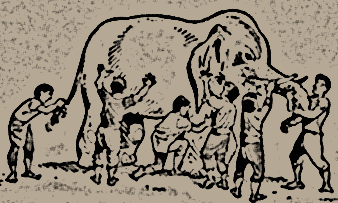Satipaṭṭhāna Sutta is one of the most popular sutta in the Pali Canon. English translations of the title include: “The Arousing of Mindfulness Discourse”, “The Foundations of Mindfulness Discourse”, “The Frames of Reference Discourse”, ”The Discourse on the Establishing of Mindfulness”, ” Four Foundations of Mindfulness”, etc. Part of the reason for the variety in this title’s translation has to do with how the compound Pāli word “satipaṭṭhāna” is analyzed. It can be interpreted as “sati-paṭṭhāna” (“foundation of mindfulness”) or “sati-upaṭṭhāna” (“presence of mindfulness”). The prefix “Maha-“, simply means “great,” or “vast”. This discourse contains the most detailed account of meditation in the Pali Canon. The Satipaṭṭhāna Sutta is the tenth discourse in the Majjhima Nikaya. Partial passages of an early Satipatthana sutta version also survive inside of some of the Prajñāpāramitā sutras.
The four foundation of mindfulness of the body, feelings/sensations, mind/consciousness, and dhammās are found in this sutta, as well as teachings such as the five hindrances, five aggregates of clinging, six internal and external sense bases, and seven factors of enlightenment
The “foundations of mindfulness” are critical meditative achievements on the path to liberation. As a meditative practice, mindfulness fits into the second stage of training, the practice of samadhi. The sutta stresses the practice of sati (mindfulness) “for the purification of beings, for the overcoming of sorrow and lamentation, for the extinguishing of suffering and grief, for walking on the path of truth, for the realization of nibbāna.”
Mindfulness is also the seventh factor of the Noble Eightfold Path. By developing mindfulness, a person first observes the various aspects of one’s being, then learns to control the mind and its reactions to external and internal stimuli. From a Buddhist point of view, this control of the mind is critical as a way to channel experiences into wholesome directions and thus avoid suffering. In this discourse, the topic of mindfulness does not focus on the specific practices of moral conduct. This is explained by the fact that, as an advanced meditative technique, mindfulness presumes the development of moral conduct.
The discourse gives specific instructions for the development of mindfulness regarding four major factors in human experience: the body, feeling, the mind, and mental objects. The Buddha instructs the meditator to “live observing body as body (feeling as feeling, mind as mind, etc.), energetically, self-possessed and mindful, having eliminated both the desire for and despair over the world.”
The discourse proceeds gradually, sequentially, and cumulatively through all four factors—the achievement at each stage constitutes a “foundation of mindfulness.” The forms of meditation suggested by the Buddha include such widely known practices as breathing and focalization techniques that lead to calm and mental clarity.
The practice begins by merely paying attention to phenomena as they arise and cease, without judging whether they are good or bad. This method means temporarily pulling back from experience and observing it with detachment, seeing each experience for exactly what it is and thereby seeing the full value of each of the possible responses to an experiential situation. Then, the Buddha describes extending such awareness to all bodily actions and mental phenomena. He stresses the necessity of being mindful when walking, eating, working and so on.
This discourse is also an excellent resource for studying the Four Noble Truths, which describe the essence of the early Buddhist doctrine in its most succinct form. In the Four Noble Truths, the Buddha points out that the problem is suffering on a variety of levels; that the underlying causes of suffering are selfish craving and ignorance; that the route to the removal of the problem is the elimination of the causes of suffering; and that the practical therapy, the Noble Eightfold Path, eliminates suffering and provides the foundations for the holy life that culminates in Nibbana.
Bhikkhus, someone who develops in this way these four foundations of mindfulness for seven rainy seasons may expect one or the other of two results: such a person may become a knower in this very world or, if some support for life remains, that person may become a ‘non-returner.’ Let alone seven rainy seasons, someone who develops in this way these four foundations for mindfulness for six rainy seasons . . . five rainy seasons . . . four rainy seasons . . . three rainy seasons . . . two rainy seasons . . . one rainy season. . . . Let alone one rainy season, someone who develops in this way these four foundations for mindfulness for seven months . . . for six months . . . for five months . . . for four months . . . for three months . . . for two months . . . for one month . . . for one half of a month. . . . Let alone one half of a month, someone who develops in this way these four foundations for mindfulness for seven days may expect one or the other of two results: such a person may become a knower in this very world or, if some support for life remains, that person may become a ‘non-returner.’
Photo credit: dhammabooks
Source: Early Buddhist Discourses by John J. Holder




